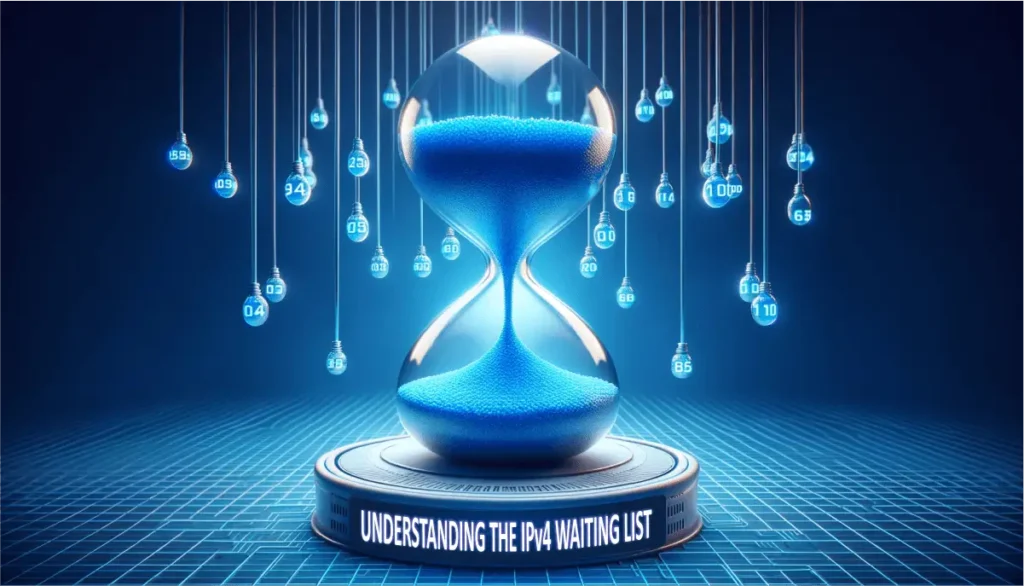IPv4, the fourth version of the Internet Protocol, has a cap of approximately 4.3 billion unique addresses. As the internet grew exponentially, the available pool of IPv4 addresses began to deplete rapidly. To manage this scarcity, some Regional Internet Registries (RIRs) introduced the concept of an “IPv4 waitlist.” This article delves into what this ip waitlist is and why it became necessary.
Table of Contents
The Onset of Exhaustion
As early as the 1990s, experts began to predict the eventual exhaustion of the IPv4 address space. Efforts were made to develop a successor, leading to the creation of Internet Protocol version 6 (IPv6), which offers a virtually limitless number of addresses. However, transitioning to IPv6 has been a slow process, and many devices and networks still rely on IPv4.
Enter the IPv4 Waitlist
To manage the dwindling supply of IPv4 addresses, some RIRs established waitlists. Here’s how it works:
- Application: Organizations that need additional IPv4 addresses but cannot obtain them due to the shortage can apply to be placed on the waitlist.
- Criteria: To be eligible, organizations typically must meet specific criteria, such as demonstrating a genuine need or showing efficient utilization of existing allocations.
- Allocation: When an RIR recovers or receives additional IPv4 addresses (from returned allocations or other means), these addresses may be distributed to those on the waitlist. The exact allocation process can vary among RIRs.
How much space can you get from the Waitlist?
AFRINIC
AFRINIC does not operate an IPv4 waiting list. Organizations can obtain blocks ranging from /24 to /22 (256 – 1024 IP addresses), depending on need.
APNIC
New APNIC members – and only new members – can receive up to a /23 block (512 IP addresses). The waiting list for existing members was closed in July 2019.
ARIN
ARIN does not allocate space to organizations that already have space equivalent to a /20 block (4096 IP addresses) or more. Those with smaller allocations can obtain blocks ranging from /24 to /22, based on need. If approved for a /22 block, they can accept a smaller block if an exact match isn’t available.
LACNIC
LACNIC members with IPv6 space can join a waiting list for an initial IPv4 allocation. They can receive blocks ranging from /24 to /22, depending on need. If approved for a /22 block, a smaller block can be accepted if a precise match isn’t available. Address space from LACNIC’s waiting list cannot be transferred, and allocations are managed on a first-come-first-served basis.
RIPE NCC
The RIPE NCC operates a waiting list exclusively for new members. Each member can obtain a block size of /24.
A Better Alternative to the Waitlist
While the IPv4 waitlist system serves as a mechanism for organizations in need of address allocations, it’s not always the most efficient or timely solution. With growing demand and limited supply, wait times can be prolonged, potentially hindering your organization’s growth and digital expansion.
If you’re seeking a more immediate and reliable solution, consider bypassing the waitlist altogether. As an established IPv4 broker, IPv4.deals specializes in facilitating the acquisition of IPv4 addresses. By working with us, you can secure the IP resources you need without the uncertainty and extended wait times associated with RIR waitlists.
Don’t let address shortages hold you back. Reach out to us today and let us help you acquire IPv4 seamlessly.
Frequently Asked Questions
What is the IPv4 Address Waiting List?
The IPv4 waitlist is a system introduced by some Regional Internet Registries (RIRs) to manage the dwindling supply of IPv4 addresses. Organizations in need of additional IPv4 addresses can apply to be placed on this waitlist.
Why was the IPv4 Address Waiting List introduced?
The internet grew exponentially, leading to a rapid depletion of the available pool of IPv4 addresses. To manage this scarcity, the concept of an “IPv4 waitlist” was introduced.
How does the IPv4 Waitlist work?
Organizations that need more IPv4 addresses but can’t obtain them due to the shortage can apply to be on the waitlist. They must meet specific criteria, such as demonstrating a genuine need or showing efficient utilization of existing allocations. When an RIR recovers or receives additional IPv4 addresses, these may be distributed to those on the waitlist.
How much space can one get from the Waitlist?
The exact allocation varies among RIRs. For example:
– AFRINIC does not operate an IPv4 waiting list but provides blocks ranging from /24 to /22.
– APNIC provides up to a /23 block for new members.
– ARIN does not allocate space to organizations that already have a /20 block or more.
– LACNIC members with IPv6 space can join a waiting list for an initial IPv4 allocation.
– RIPE NCC operates a waiting list exclusively for new members, offering a block size of /24.
Is there an alternative to the IPv4 Waitlist?
Yes, bypassing the waitlist altogether and working with established IPv4 brokers like IPv4.deals can be a more immediate and reliable solution. They specialize in facilitating the acquisition of IPv4 addresses, allowing organizations to secure the IP resources they need without the uncertainty and extended wait times associated with RIR waitlists.





